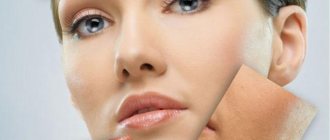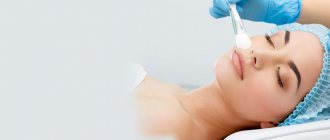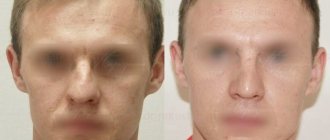Scar
is the result of the biological process of healing wounds of the skin or other tissue resulting from injuries, burns, operations and diseases, without which no living organism can exist.
According to WHO analytical data, about 50 million people are injured annually in the world, more than 100 million undergo surgical interventions, which leave scars. Keloid and hypertrophic scars are observed in 4.5% - 10% of the general population.
Diagnosis of pathological scars does not present great difficulties and is based on anamnestic data and clinical manifestations. However, despite the keen interest of scientists in this problem, it should be recognized that until now the degree of understanding of the processes occurring in tissues leaves much to be desired and often comes down to empiricism.
Correction of scar deformities is one of the most difficult tasks in aesthetic medicine. Scars are not only a source of aesthetic and psychological problems, but also cause a number of unpleasant subjective sensations. Currently, there are a large number of scar treatment methods, but none of them alone can guarantee quality. This problem requires an integrated approach and the involvement of doctors of several specialties - surgeons and dermatocosmetologists.
§1. Types of scars
Acne scars
What is an acne scar? In fact, this question is much more complex than you might imagine. After the pimple heals, a red or brown spot remains in its place. These spots are temporary and disappear within two to six months. These are not real scars, although many people refer to temporary changes in skin color as scars, which is actually a mistake.
A real acne scar is a formation (in the form of a lump or pit) that remains on the skin forever. The formation of scars and scars most often occurs with cystic acne, less often - after the healing of pustules (if they were very inflamed). The scar feels denser to the touch than the surrounding skin.
Cosmetologists classify several types of acne scars.
Thus, raised scars are identified (outwardly they look like ordinary pimples). There are also “crater” scars (when small depressions form in the skin) and hole scars (as if the skin was pierced by a needle).
Treatment depends on the number and type of scars. The most common treatments for acne scars are excision, subcision, skin grafting, laser light, dermabrasion, and hyaluronic fillers (such as Restylane and Juvederm).
Scars left after surgery
Over the past few years, I have undergone several surgeries, and the stitches have always healed normally. Six months ago I had surgery on my shoulder, the stitches healed very slowly, and the scar turned out to be large and ugly. Why did it happen?
How quickly sutures heal depends on a large number of factors. But the main indicator is the load on the sutures: the lower the load, the faster the sutures heal, and the more accurate the scar. For example, sutures around the eyelids and scars after a cesarean section heal very well - since there is a lot of loose skin there, the sutures receive little stress.
If we consider your case, then the shoulder joint where the sutures were placed on you had a fairly large load - you were constantly moving your arm, and the skin could have been pulled too tight during the operation. The more you worked with your hand, the more your seam stretched, which is why it turned out so big and ugly. If the operation had been performed on the abdomen, then, with a high degree of probability, a thin, almost colorless scar would have formed there.
With age, a person’s skin loses its elasticity and becomes more stretched, so the stitches heal easier, and the resulting scars are not so scary in appearance. In young people, on the contrary, the skin is so elastic that the scar stretches and increases in size at the slightest movement.
To minimize the possibility of scar stretching, surgeons often place additional, invisible to the prying eye, sutures in the deep layers of the skin. These sutures reduce stress on the muscles and the wound. Subcutaneous sutures are not removed, as they are applied using self-absorbing threads; healing of internal sutures occurs within four to twelve weeks.
The doctor may also recommend sticking special patches on the wound for the first few months (so that the scar is as flat, soft and narrow as possible).
Most often, terrible scars form in the décolleté area, on the joints and back (especially in people whose activities involve lifting heavy objects).
Scars left after accidents
Not long ago, I was in a terrible car accident that left me with several huge scars on my body. I want to get rid of them as soon as possible, but my doctor told me to wait 6-12 months. What is the need for such an expectation?
You know that after stitches are placed on a wound, a scar forms at this place. The process of scar formation is quite long: in the first six to eight weeks, only 60% of the scar is formed, another 10 months are required for it to “ripen”, so to speak, and only then can you think about treating it.
One to two weeks after surgery, the sutures are removed. If the doctor is experienced, he will advise the patient to apply a tightening bandage or plaster to the wound for the first few weeks, or even months (they can be bought at any pharmacy). On the fixed area of skin, the seams are formed narrower and smoother.
Healing of the scar under the skin occurs for at least a year from the moment the stitches are applied, which is why doctors recommend not to rush to remove them. Even if you do nothing with the scar, it will gradually smooth out and fade due to the efforts of your body (and its capabilities, believe me, are absolutely amazing). If nothing has changed in the first year, i.e. if the seam is just as red and convex, then it makes sense to consult a specialist and try to get rid of the scar with the help of medicine.
But if in the first six to eight weeks the itching does not stop, and the pain only intensifies, then you should immediately contact your doctor (in order to exclude the possibility of the formation of a keloid scar).
Keloid and hypertrophic scars
I recently had a mole removed from my décolleté area. Now this place looks much worse than before the operation! The seam has bulged and hardened, and sometimes it hurts and itches.
Judging by the description, you have either a keloid or a hypertrophic scar. Let's agree and call this scar a keloid (since these two types of scars require the same treatment). Over time, the suture should become flat and soft, but if it hardens and rises, if the pain and itching do not go away, then this means that a keloid has formed.
Keloid formation begins four to eight weeks after surgery, sometimes a little later. A keloid can appear both after surgery and after a previous illness (for example, after acne). Keloids can form absolutely anywhere on the body, but most often they appear in the décolleté area, on the shoulders, in the upper back, and in places where piercings were made (especially on the ears). The likelihood of developing keloids is highest during adolescence, but remains high until age 30. But there are people on whose body keloid scars can form throughout their lives.
If your skin is prone to keloid scars, be sure to tell your doctor about this, as the sooner you start fighting the keloid, the better your chances of getting rid of it. There are even special techniques that, when performed immediately after surgery, eliminate the formation of keloid scars. But if time is lost and a full-fledged keloid has formed, then it will be very difficult to fight it, it will take a lot of time and effort.
How to remove keloid scars?
This is where anti-inflammatory drugs (in the form of injections into the scar itself), patches, silicone and various topical creams, such as Biafine, come to the rescue. Complete removal of keloid scars using a laser is impossible, but laser radiation can not only give the scar a natural color, but also significantly improve its texture.
Stretch marks (striae)
Stretch marks are scars that form from the inside. When the skin stretches too quickly, the collagen and elastic fibers that give the skin its elasticity become torn. Since cracks form under the skin, the integrity of the skin is not compromised.
Most often, pregnant women, and especially those women who are carrying twins and triplets, suffer from stretch marks on the abdomen. The appearance of stretch marks is also possible in adolescence, i.e. during the period of active growth of the whole organism. In boys, stretch marks most often form on joints (for example, shoulders), in girls - on the hips. It is possible that stretch marks may form in adulthood, in particular when a person gains weight very quickly.
To date, stretch marks have no treatment, and, unfortunately, there is no scientific evidence that oils with vitamin E or special creams and gels for stretch marks actually work. Many people say that the drug Retin-A and the dermabrasion procedure helped them a lot in the fight against stretch marks, but scientific confirmation of these statements has not yet been made.
What there is no doubt about is that laser radiation (in particular, produced by the Fraxel laser) works well against stretch marks. After the procedure, red stretch marks become discolored.
Recently, the use of fractional ablative laser systems has become increasingly widespread. Yes, laser resurfacing of scars gives good results, but since this technique has not yet been fully studied, its use must be treated with extreme caution.
Some stretch marks disappear on their own over time. We recommend our article on fighting stretch marks.
Healing: one of the important stages of scarring
If healing a tattoo is a rather complex process, then scarification is several times more difficult. This must be done carefully, sterilized and clean.
If you do not comply with these requirements, you can get dangerous blood poisoning, which can end very badly. Keloid scars are also one of the dangers. They will result from incorrect scarification.
§2. Removing scars and acne scars
Is there a cure for acne scars?
Before we talk about how to get rid of acne scars, let's answer this question. Is it possible to prevent scar formation?
Yes, most often it is possible to do this. You can avoid the formation of scars if you start taking Roaccutane or some other highly effective drug in time, for example, an oral antibiotic, an oral contraceptive (for women), if you start treating acne with special gels and creams before the entire face is covered with scars and scars. If you suffer from acne and see that scars have already begun to form, immediately contact your doctor and read our recommendations. If conservative treatment has failed, consider using Roaccutane. If the disease begins to develop very quickly from the first days, then it makes sense to start treatment with Roaccutane.
Excision
Many acne scars (particularly those that look like a small, narrow hole) can be treated with a technique called excision. Using a special instrument, an incision is made inside the scar, then an intradermal cosmetic suture is placed there, which tightens the edges of the scar, making the surface of the skin smooth and even. After some time, the stitches are removed and the wound heals. But it also happens that additional treatment is required, such as chemical peeling, laser resurfacing, or even skin transplantation, which we will talk about a little later.
Subcision (cutting scars)
After I had acne, my whole face was covered with wide craters. My doctor suggested that I undergo subcision as a panacea for these terrible scars. Please explain to me what this procedure is.
Firstly, your doctor is absolutely right, since subcision is precisely designed to combat funnel scars.
To understand what the action of this procedure is based on, let's understand the mechanisms of scar formation. The appearance of a pimple on the skin leads to disruption of collagen production, i.e. Collagen is not formed in the right place.
During the procedure, the doctor inserts a special needle under the skin, with which he trims the scar (i.e., separates it from the deeper tissues). Blood leaks into the area where the base of the scar is cut. Over time, the incision site fills with collagen and the scar straightens out.
Six months after the procedure, it is advisable to treat the affected areas with a laser - laser radiation will stimulate collagen production.
Depending on the number and depth of scars, the patient may need one to four sessions. A slight improvement is noticeable after each procedure. The only drawback of this subcision is the formation of small bruises that remain on the face for one to two weeks (although they can be disguised with makeup). The interval between sessions should be four to twelve weeks.
You can consolidate the result after subcision using laser resurfacing, dermabrasion and medium TCA peeling.
Laser removal of acne scars
What lasers are used to treat acne scars? And how do they work?
Read our detailed article on laser scar removal.
Hyaluronic fillers Restylane and Juvederm to combat acne scars
After I had acne, I had a lot of scars on my face. My doctor advised me to try to get rid of them with Rateline. Is this the right tactic?
In fact, Restylane and Juvederm work great on acne pitting scars. But with scars that resemble a puncture, these drugs are practically powerless. The only disadvantage of Restylane/Juvederm is that the effect after their use is short-lived: the procedures, depending on the characteristics of the body, must be repeated once every two to six months. These drugs can be used, but the effect they provide is temporary.
Dermabrasion
My dermatologist prescribed dermabrasion for my acne scars. What is the difference between dermabrasion and laser resurfacing?
Both laser resurfacing and dermabrasion show absolutely amazing results. Gradually, laser resurfacing is replacing dermabrasion, but this procedure, in the hands of a professional cosmetologist, is a wonderful means of combating acne scars.
Dermabrasion, perhaps like no other cosmetic procedure, requires that it be performed by a trained and experienced professional. Now doctors who can actually perform the procedure efficiently are already 50 years old, maybe more. Younger dermatologists have little to no experience performing dermabrasion, as lasers were already widely used by the time they began working.
Dermabrasion can be performed on the entire face or on just one area. Before the procedure begins, the surgical site is numbed with a local anesthetic. The dermabrasion device looks like a drill, but instead of a drill, special diamond-coated attachments are used.
Another reason why dermabrasion is being used less and less is that this procedure is very bloody. And if the patient has HIV or hepatitis, then the doctor has every chance of becoming infected with these terrible viruses. If you want to know more, read about facial dermabrasion and its capabilities.
Chemical peels
I asked my dermatologist if I could use a chemical peel to get rid of my acne scars. And the doctor said no. Why?
For trichloroacetic acid to work, the scars must be as superficial and soft as possible. Even with a deep TCA peel, getting to the base of an acne scar is very difficult. In addition, in some areas the acid is absorbed better, in others - worse, so some scars require a higher concentration of the active substance, others - a smaller one.
The best way to remove acne scars is through dermabrasion and laser resurfacing. During the procedure, the doctor sees which scar requires more attention, so he will treat it several times, and less serious scars will receive less treatment.
Skin graft
I have a lot of acne scarring on my face and my doctor recommended a skin graft. Tell us about this procedure.
During this procedure, the scar is cut out using a special instrument, and another piece of skin is applied in its place. Most often, the area behind the ear acts as a donor area. The cut skin is either sewn on or simply fixed with adhesive tape. The donor area is sutured, the sutures heal quickly and become discolored.
It often happens that the transplanted skin bulges a little. There are several ways to lower it, but dermatologists most often resort to the tools used for dermabrasion. Some time after surgery, laser resurfacing or dermabrasion of the entire face can be performed to make the skin more even and smooth.
Skin grafting is practiced by many dermatologists as this method of scar removal is actually very effective. But you should keep in mind that such an operation cannot be performed on all acne scars.
What is scarring: basic concepts
(watch 10 minutes)
Scarification, scarification, scarring is a surgical intervention in the human skin with the purpose of applying a certain pattern. As a rule, this technique is used either by people who already have scars and want to hide them, or by fans of extreme body modification.
Like any body modification technique, scarification has its own history. It is quite old and refers to slightly frightening methods. Today it has become one of the avant-garde art movements.
The process of scarring is quite a painful procedure. That is why it is done under local anesthesia - the area of the body is numbed with the help of medications. Where there will be a drawing in the future, a medicine is injected in a circle, which leads to numbness of the skin.
Note.
Those who tolerate the pain more easily can use the cream; others require injections.
§3. Removing scars left after operations and accidents
Several years ago I had a mole removed from my back. The scar turned out to be very large and ugly. What can I do with this scar now?
If the scar is soft and flat, but very large, then it can be cut out. During the operation, the doctor removes the scar and re-stitches it. To better fix the wound, the surgeon may make several internal sutures. It is also advisable to apply tightening plasters and bandages to the seam over the next few months.
The patient may also be advised to abstain from certain types of exercise for a while. If you lead an active lifestyle: play sports or just do gymnastics every morning, then discuss each individual exercise with your surgeon. If immediately after re-removing the scar you engage in weightlifting or rowing, then there is no point in doing this operation for you - the new suture will also stretch.
Plasters, silicone strips, silicone gels and Biafine cream for the care of scars and scars
My friend advised me to try removing my scars using silicone strips. Are they really that effective?
In recent years, a real advertising campaign has been underway to promote various silicone-based drugs. The most common of these are silicone strips, which are cut to the shape of the scar and worn for a certain period of time. There are also silicone gels, for example Mederma. This gel is applied to the scar once or twice a day to soften the scar and give it a more presentable appearance.
In order to study the effect of silicone-based preparations, a large number of studies have been and are still being conducted, and most experts have come to the conclusion that silicone-containing preparations can actually make the scar less noticeable. True, there are critics. Many dermatologists claim that silicone strips are no more effective than regular patches.
In any case, if you want to test the effectiveness of such drugs for yourself, then remember that the fresher the scar, the easier it is to deal with it, and, conversely, the more time has passed since the formation of the scar, the more difficult it is to influence it.
Many dermatologists recommend using regular bactericidal patches. If you stick such patches on the wound for at least several weeks, the scar will not stretch or become rough. Such patches can be bought at any pharmacy; another advantage is their low price (especially compared to silicone patches). Ideally, the wound should be covered with adhesive tape 24 hours a day for several months.
If the scar is on the body and is hidden under clothing, then the patch can not be changed every day, but as needed (that is, when it comes off on its own), and it is not necessary to remove it at all, for example, when you go to the shower. If you decide to change the patch daily, you risk getting skin irritation from the patch itself. It may also happen that the patch causes an allergy, the skin turns red and starts to itch - then peel off the patch immediately. If a bactericidal patch is not suitable for you, then turn your attention to silicone-containing preparations.
There is another new generation drug - Biafine cream. The cream is rubbed into the scar with light massage movements twice a day. Improvement is visible after three to four weeks of use. Biafine cream can be used for a long period of time; it causes virtually no side effects. The only thing is that Biafine is sold in pharmacies only with a doctor's prescription. The cream is not cheap - it costs about $50.
Laser removal of scars left after operations and accidents
Read our detailed article on laser scar removal.
Fillers to combat scars left after operations and accidents
Hyaluronic fillers Restylane and Juvederm can only cope with depressed scars. Fillers lift sagging areas of the skin, making the skin even out and look natural. The only disadvantage of Restylane and Juvederm is that their results are short-lived. Repeated procedures should be done once every four to six months. Talk to your doctor about the possibility of using fillers on your skin.
Who can you trust for scarring: rules for choosing a master
When deciding to undergo body scarification, you should understand how responsible it is. If with a tattoo there is still a chance that an acquaintance or friend will get it done, then with scarring this will not work. Not every salon is able to provide the necessary conditions for a session.
It is worth understanding that this is essentially a small microsurgical operation. Therefore, to realize your dream, you need to find a good master and ensure absolute sterility.
Ideally, the master who performs the procedure should have a medical education. In this style, experience plays a much larger role than in tattooing. Pay attention to the fact that the master has been engaged in scarification for so many years.
Simple tattoos are radically different from scarring. Statistics show that the more procedures performed, the better. Of course, if these procedures went well and without negative consequences.
Just like after getting a tattoo, you need to constantly and very carefully care for the scarred area. If this is not done, the result can be disastrous. From the most harmless abnormal tissue fusion to suppuration. First of all, you need to wash the wound every day with saline solution and wear a special bandage.
§4. Keloid scars
Injections to combat keloid and hypertrophic scars
My doctor advised me to get rid of the scar with injections. How does this method work?
Dermatologists around the world have been fighting keloid scars using injections for many years. Your doctor will use a needle to inject a strong anti-inflammatory drug directly into the scar. As a rule, several sessions are required for complete healing, the interval between which should be three to four weeks.
The cause of keloid scars is a failure in the process of collagen formation. After the wound heals, the formation of collagen should stop, but it happens that it continues to form, including on the surface of the skin. If, in addition to everything, an inflammatory process also begins there, then the scar turns red. Anti-inflammatory injections injected into keloids stop not only inflammation, but also collagen production. Gradually, the scar softens, decreases in size, and stops hurting and itching.
The needles used for injections are so thin that they cause virtually no pain. But if the keloid is inflamed, then the injection can be felt and cause considerable discomfort. Over time, the inflammation goes down, so subsequent injections are less painful.
Laser removal of keloid, hypertrophic and red scars
I have one large red keloid scar on my skin. Thanks to the injections, he began to look a little better, but my doctor advised me to continue laser therapy. What do you think about it?
Read our detailed article about laser removal of keloids, hypertrophic and red scars.
Types of scarring: basic concepts
Due to its rather long history, scarification has several application methods. Thanks to the development of technology, even laser burning has become possible. However, it is necessary to consider everything in order.
- The first type of scarring is burning or branding. Most often, when burned, the scars remain somewhat concave in depth. During the procedure itself, the pain is sharp and stronger than during cutting, but it goes away much faster.
Note . When choosing branding, you should be prepared for the fact that the drawing will not be accurate enough. Therefore, it is necessary to abandon complex images and opt for something simple.
- The second type of scarring is cosmetic skin excision. This method is characterized by cutting the skin perpendicularly with a scalpel. After this procedure, a barely noticeable scar remains. However, this benefits the drawing itself. It remains very clear with no inaccuracies.
Note.
Excision is possible with a slight inclination of the scalpel. In this case, the wound turns out to be somewhat deeper. The resulting effect allows you to play with the relief of the image.
- The third method of scarring is considered the most painful - cutting off the very layer of skin. If, during branding or cosmetic cutting, the skin remains in place and is only separated, then in this case it is completely eliminated.
Note.
This type is used to obtain large drawings. True, the price to pay for this will be a fairly large piece of skin.
- The fourth method is abrasion. In this case, the skin will be erased using devices, thus creating the necessary pattern. Among them are various abrasive materials or suspensions. In the roughest sense, the process will resemble working with sandpaper. However, this comparison is not entirely accurate - much more gentle materials are used there.
§5. How to treat scars: conclusions
The choice of one therapy or another depends on the type of scar. And only a doctor can correctly assess the situation and prescribe the appropriate treatment.
Traditional methods such as injections, skin grafting, scar revision and subcision are not only proven but also quite effective ways to deal with scars.
Laser scar removal is not a cheap procedure, but it is this therapy that shows the best results in the treatment of red scars and other types of scars. Using non-ablative fractional systems, acne scars can be improved by 50-75%. Ablative fractional lasers have been very successful in treating teenage acne.
All you need is to find a qualified and experienced dermatologist.
Marie Novosad, blogger, 25 years old
At 11 months I spilled hot porridge on my right arm, right chest and neck area. As a teenager, I had a terrible complex and wore long sleeves even in the heat and loaded myself with studies as much as possible, just to avoid meeting people and asking questions. Other people's interest made me want to hide my scars. But today I wear tight slips, post photos on Instagram in underwear, dance on the pole, do an online course on self-love, and recently, together with a friend, I launched a sex shop.
Changes began when I started my YouTube channel. Then I decided that I couldn’t be afraid of prying eyes all my life. First, I stopped hiding the burns while filming the video, and then I recorded a separate story about them. Many subscribers who thanked me for showing my scars accelerated the process of accepting myself. Yes, I have scars on my arms, but I have arms that I can hug with. And once I realized how much I was given, I stopped worrying about scars.
Marie Novosad, Vogue Russia, November 2020
Right way of life
How to treat scars and scars on the face? It is also worth thinking about your bad habits, lifestyle, etc. After all, even such simple moments affect the skin and its condition. For example, play more sports, lead an active lifestyle, give up bad habits, and sleep enough time so that your body has time to recover. In addition, you should watch your diet and avoid stressful situations. Following these simple rules will help avoid the appearance of acne, and as a result, scars.
Karina Istomina, DJ, co-host of a YouTube show, 26 years old
At the age of 25, after the removal of a wisdom tooth, I developed a complication that led to inflammation - phlegmon. To get to the source, doctors made an incision under the chin across the neck, deep to the tongue. They sewed it up as if with a sewing needle. At first I suffered wildly: no girl would want a scar on her face. But then she started joking: “Now I’m the Joker.” And, having checked out, I immediately went to filming. The main thing is to take everything lightly. During recovery, I listened to Mac Miller's Circles album and read the autobiography of Red Hot Chili Peppers singer Anthony Kiedis, Scar Tissue.
His philosophy of self-acceptance helped me a lot, so I got a tattoo of the book's title. In general, I have a lot of scars, my whole arm is cut up. I had severe bouts of selfharm a couple of years ago. I lived in constant shame for a long time. But I accepted myself and started talking about it on the Internet a few months ago. We don’t choose scars from accidents or operations, but we shouldn’t be ashamed of pain either.
Karina Istomina, Vogue Russia, November 2020











